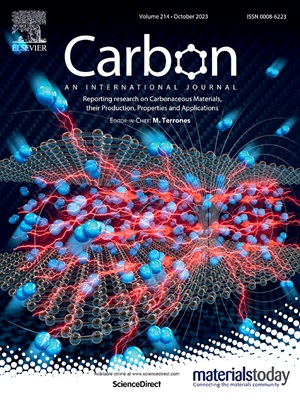Nanoarchitectonic grafting of NiCo-layered double hydroxide on fullerene-derived carbon nanorods for hybrid supercapacitors
IF 11.6
2区 材料科学
Q1 CHEMISTRY, PHYSICAL
引用次数: 0
Abstract
Improving the electrochemical performance of hybrid supercapacitors (HSCs) through the synergistic modulation of battery-type materials with nanoporous carbon is a crucial strategy for advancing energy storage. In this study, we synthesized NiCo-layered double hydroxides on fullerene-derived carbon nanorods (FNR-800@NiCo-LDH) via high-temperature carbonization of fullerene nanorods followed by a hydrothermal process. The encapsulation of NiCo-LDH on FNR-800 results in excellent electrochemical performance due to the multi-oxidation states of nickel and cobalt species and the high surface area of FNR-800. The FNR-800@NiCo-LDH electrode exhibits battery-type redox behavior with a high specific capacitance of 1396.1 F g−1 at 1 A g−1, a good rate capability of 69.8 %, and superior cycling stability of 93.1 % over 5000 cycles. Additionally, an asymmetric cell constructed with FNR-800@NiCo-LDH as the positive electrode and FNR-800 carbon as the negative electrode demonstrated a specific energy of 68.8 Wh kg−1 at a specific power of 800 W kg−1, along with high rate capability and excellent cycle stability over 5000 cycles. This strategy of integrating metallic species with carbon nanoarchitecture effectively regulates the redox activity of materials, paving the way for their practical application in future energy storage applications.

杂化超级电容器在富勒烯衍生碳纳米棒上nico层状双氢氧化物的纳米结构接枝
通过电池型材料与纳米多孔碳的协同调制来提高混合超级电容器(hsc)的电化学性能是推进储能技术的关键策略。在这项研究中,我们通过富勒烯纳米棒的高温碳化和水热工艺,在富勒烯衍生的碳纳米棒(FNR-800@NiCo-LDH)上合成了nico层状双氢氧化物。NiCo-LDH包埋在FNR-800上,由于镍和钴的多氧化态和FNR-800的高比表面积,使得FNR-800具有优异的电化学性能。FNR-800@NiCo-LDH电极具有电池式的氧化还原性能,在1 a g−1下具有1396.1 F g−1的高比电容,69.8%的良好倍率能力,5000次循环中具有93.1%的优异循环稳定性。此外,以FNR-800@NiCo-LDH为正极,FNR-800为负极的非对称电池在800 W kg - 1比功率下的比能量为68.8 Wh kg - 1,具有高倍率性能和超过5000次循环的优异循环稳定性。这种将金属物种与碳纳米结构结合的策略有效地调节了材料的氧化还原活性,为其在未来储能应用中的实际应用铺平了道路。
本文章由计算机程序翻译,如有差异,请以英文原文为准。
求助全文
约1分钟内获得全文
求助全文
来源期刊

Carbon
工程技术-材料科学:综合
CiteScore
20.80
自引率
7.30%
发文量
0
审稿时长
23 days
期刊介绍:
The journal Carbon is an international multidisciplinary forum for communicating scientific advances in the field of carbon materials. It reports new findings related to the formation, structure, properties, behaviors, and technological applications of carbons. Carbons are a broad class of ordered or disordered solid phases composed primarily of elemental carbon, including but not limited to carbon black, carbon fibers and filaments, carbon nanotubes, diamond and diamond-like carbon, fullerenes, glassy carbon, graphite, graphene, graphene-oxide, porous carbons, pyrolytic carbon, and other sp2 and non-sp2 hybridized carbon systems. Carbon is the companion title to the open access journal Carbon Trends. Relevant application areas for carbon materials include biology and medicine, catalysis, electronic, optoelectronic, spintronic, high-frequency, and photonic devices, energy storage and conversion systems, environmental applications and water treatment, smart materials and systems, and structural and thermal applications.
 求助内容:
求助内容: 应助结果提醒方式:
应助结果提醒方式:


